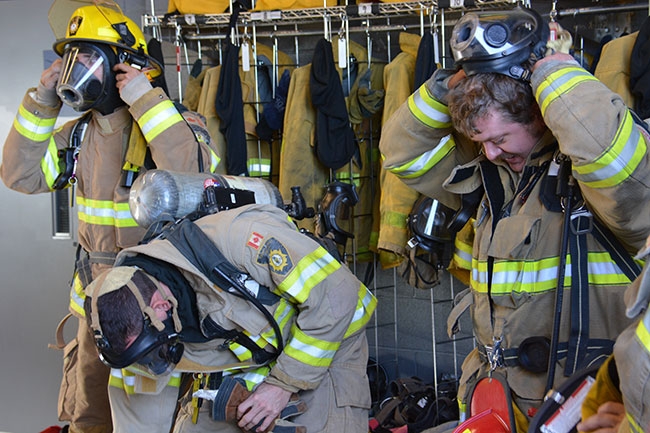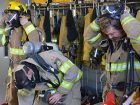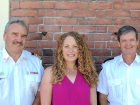
Features
Health and wellness
Hot topics
Holistic heroes: How departments can maximize firefighter well-being
The employer plays a significant role in supporting the health and well-being of our most important asset – our firefighters. Fire chiefs manage the fire department assets through business plans, strategic and operational plans, as directed by the municipal council or regional district.
November 9, 2017
By Dave Cockle Sara Wegwitz and Ken Gill
 Firefighters are the most important asset to any local fire service. Having a departmental health and wellness program can help to maximize mental and physical efficiency both at home and in the fire hall. The Oak Bay Fire Department in British Columbia is maximizing firefighter efficiency with a holistic health program. Program facilitators Chief Dave Cockle
Firefighters are the most important asset to any local fire service. Having a departmental health and wellness program can help to maximize mental and physical efficiency both at home and in the fire hall. The Oak Bay Fire Department in British Columbia is maximizing firefighter efficiency with a holistic health program. Program facilitators Chief Dave CockleWe allocate funds to manage the business of the fire department including the repair and replacement of fire department assets such as: fire engines, pumps, hoses, tools and station maintenance to name a few. Ask yourself how much time during any given shift pattern do we spend on ensuring that our No. 1 asset is fully functional and fit to meet the various challenges of the day? This is the question the management team at the Oak Bay Fire Department asked in 2014.
The Oak Bay Fire Department (OBFD) in British Columbia consists of 26 career members operating a single-engine company or ladder company, and includes a one-person fire prevention division and the emergency management program director for the District of Oak Bay.
In 2012 and 2013, the department averaged 12 to 14 days of sick leave benefits per member. OBFD management initially looked at the reactive approach to managing staff that was engrained in our fire-department culture, and quickly realized the system was broken. We chose to examine the underlying, systemic problems in the department that were affecting the well-being of our members. The one constant we found was a lack of preventative maintenance for our firefighters. We were spending countless hours ensuring our trucks and tools were ready for action, but we were not investing in our people the same way.
The management team reviewed what other fire departments were doing, both locally and provincially, to prepare their firefighters. The program is based on the principles set out by the IAFF/IAFC in the Joint Labor Management Wellness/Fitness Initiative and Oak Bay has tailored its program to better suit its members and their needs. We used the initiative as a guideline to come up with a holistic approach to address the health and wellness of our people.
With the full support of the department management team and unionized members, we developed a health and wellness initiative committee; contracted a registered nurse who specializes in developing tailored health and performance programs; and integrated a chaplain into the program. The program was designed to help improve our members’ overall well-being and quality of life. We were detailed and specific in the terms of reference: the program was to address body, mind, and spirit. To achieve this, we used the following guiding principles:
- Ensure that the fire department members sustain and/or improve their overall health
- Improve employee understanding of issues that impact their health and well-being
- Provide assistance and coaching to employees to help them manage and understand the stressors that affect their health on a day-to-day basis
- Encourage employees to take ownership of their health
- Ensure all aspects of the health and wellness program meet budget guidelines
- Ensure that each crew’s platoon health leaders are supported in their role
■ Implementation
Making changes in the fire department can be slow, however timing is everything. The union was engaged; politically, all levels of labour management continue to recognize the job-related health issues many first responders face.
There were some hurdles to overcome concerning the daily structure in the department. Some of the questions that we needed to address included: How do we fit this initiative into an already busy schedule? How do we get buy-in from the membership? How do we obtain funding from council to support the program?
The adage “anything worthwhile is worth the effort” comes to mind. In a unionized environment, the key to any change is to establish communication early, listen to members’ concerns, identify roadblocks, and work to create a functional program.
The local was very aware of the health and wellness concerns of our members, and union leaders were also looking for avenues to improve firefighter well-being. One of the biggest challenges was to educate members and the municipal management team that the program was not simply a gym workout every day, but a program that was about body, mind, and spirit – including mental health, nutrition, sleep, hygiene practices, and physical exercise.
The health and wellness program also includes educating firefighters’ family members at training sessions that focus on first responder mental health. These sessions provide some tools to help family members recognize symptoms of stress, gain coping strategies, and learn how to access assistance. Maintaining the confidentiality of each member’s health and well-being status was critical to the success of the program. It was important that no information regarding members’ health and well-being were shared with the employer. This was resolved by having the registered nurse work with each member privately when discussing health concerns.
■ Council
The health and wellness team provided our chief administrative officer and council with a presentation on the health challenges present within the department at the time of the program’s inception. These included high levels of stress, sickness, multiple soft tissue and joint injuries, and fatigue. We also identified the common chronic illnesses for firefighters, such as heart disease, depression and cancers. We then unveiled a plan for a comprehensive and holistic program that would ultimately reduce, prevent, and mitigate the risk of firefighters acquiring an occupational disease or injury. The dividends of such a program include:
- Decreased costs related to injury and decreased sick time
- Increased health of all members, mentally, physically and emotionally
- Enhanced personal responsibility for health and wellness
- Increased levels of performance on the job, as well as in other aspects of life
- Increased morale and a more positive work environment
- Upstream approach helps to identify current stressors and assist the individual to address behaviour before negatively impacts their health
Other key program elements that were of interest to council included:
- Oversight of the program as a joint management-labour function supported and facilitated by an experienced health and wellness professional
- The program follows recognized legislation and firefighter standards relating to occupational health and safety, and NFPA 1500 and NFPA 1538
■ Medical oversight
We cannot understate the importance of having an experienced health professional oversee and facilitate the program. Our RN, Sara Wegwitz, ensures the program stays within the terms of reference and provides firefighter-specific health and wellness training throughout the year. Wegwitz’ role opens the door to the health world and provides our members access to resources that support the program goals and objectives. Through the program we have had many guest health professionals give presentations to our firefighters about how to eat, move, sleep, and even think, so that they are mentally and physically prepared for each shift. These presentations take approximately one hour and can easily fit into a drill period on a quarterly basis.
The health professional also plays a key role in fostering trust and confidentiality with each member to provide another portal of access to more personalized support and resources. This enables a degree of separation between the employer and employee regarding each firefighter’s personal health and level of growth in the program. Having a health professional’s perspective when it comes to health and wellness programming has been instrumental in the sustainability of our program.
■ Chaplaincy
OBFD is very fortunate to have a well-respected retired member of our department serve as our fire chaplain. Ken Gill is forward thinking, and when approached about the program, he was fully supportive. A chaplaincy element gives firefighters and their families greater guidance through the mental well-being and spiritual component of the program. Gill is trained and certified by the Federation of Fire Chaplains. He is also a member of the B.C. Association of Fire Chaplains and has taken specialized training in pastoral counselling, grief and loss, and mental health. The main role of the chaplain is to be a confidential and supportive presence; this presence is achieved by building and maintaining caring relationships with the firefighters and their families, often through personal contacts, regular station visits and involvement in various department activities. The chaplain provides an important resource to our members and their families by serving with compassion and understanding without judgement. The chaplaincy is extremely valuable to the program; our members have confidence in the chaplain to provide assistance with the mental and spiritual challenges of the fire service.
■ Fire department management
Management worked collaboratively to update operational guidelines for sick leave, modified-duty / return-to-work, and attendance-management policies. In addition, we created a health and wellness policy to ensure sustainability and give direction to the program in the future. This step creates accountability, encouraging all members to participate. Our investment in the program is $380 per member per year, but our return is three times the investment in reduced sick leave and backfill. We have reduced sick leave average from about 13 days to 5.5 days within a year since the program was introduced, and our firefighters are more mentally and physically prepared to complete the tasks the day may bring. The department schedule was adjusted to provide the optimum time for health and wellness during the shift as operational requirements permit. A simple change such as meal-break timing for during an evening shift can make an enormous difference. Recent complementary additions to our program have included training our firefighters in the Canadian Mental Health Association’s Resilient Minds train-the-trainer course and updating our approach to critical incident stress management and peer counselling.
The fire service is constantly challenged to sustain a high level of efficiency and effectiveness. By re-allocating some of your resources to your greatest asset – the firefighter – you can reduce the cost of employer-paid benefits and enhance the well-being of your firefighters to enable them to operate at peak efficiency. The changes, although subtle, have made drastic improvements in the culture, morale, and the overall health and well-being of our members. Investing in your firefighters’ health and well-being may cost more money upfront, but from our experience in Oak Bay, the dividends the program is yielding to our members and their families is priceless.
Chief Dave Cockle has been a career firefighter with the Oak Bay Fire Department for 30 years. He is a founding member and chair of the BC Earthquake Alliance and ShakeOut BC. Contact him at dcockle@oakbay.ca
Sara Wegwitz is a registered nurse who specializes in mental fitness and resilience training. She provides training and education to a number of fire departments across British Columbia and is the primary facilitator of the Oak Bay Fire Department’s wellness program. Contact her at sara@tailormakinghealth.ca
Ken Gill retired as a captain/inspector with the Oak Bay Fire Department in 2014. In April 2015, Ken was appointed as the
department’s fire chaplain. Contact him at obfdchaplain@shaw.ca
Print this page




